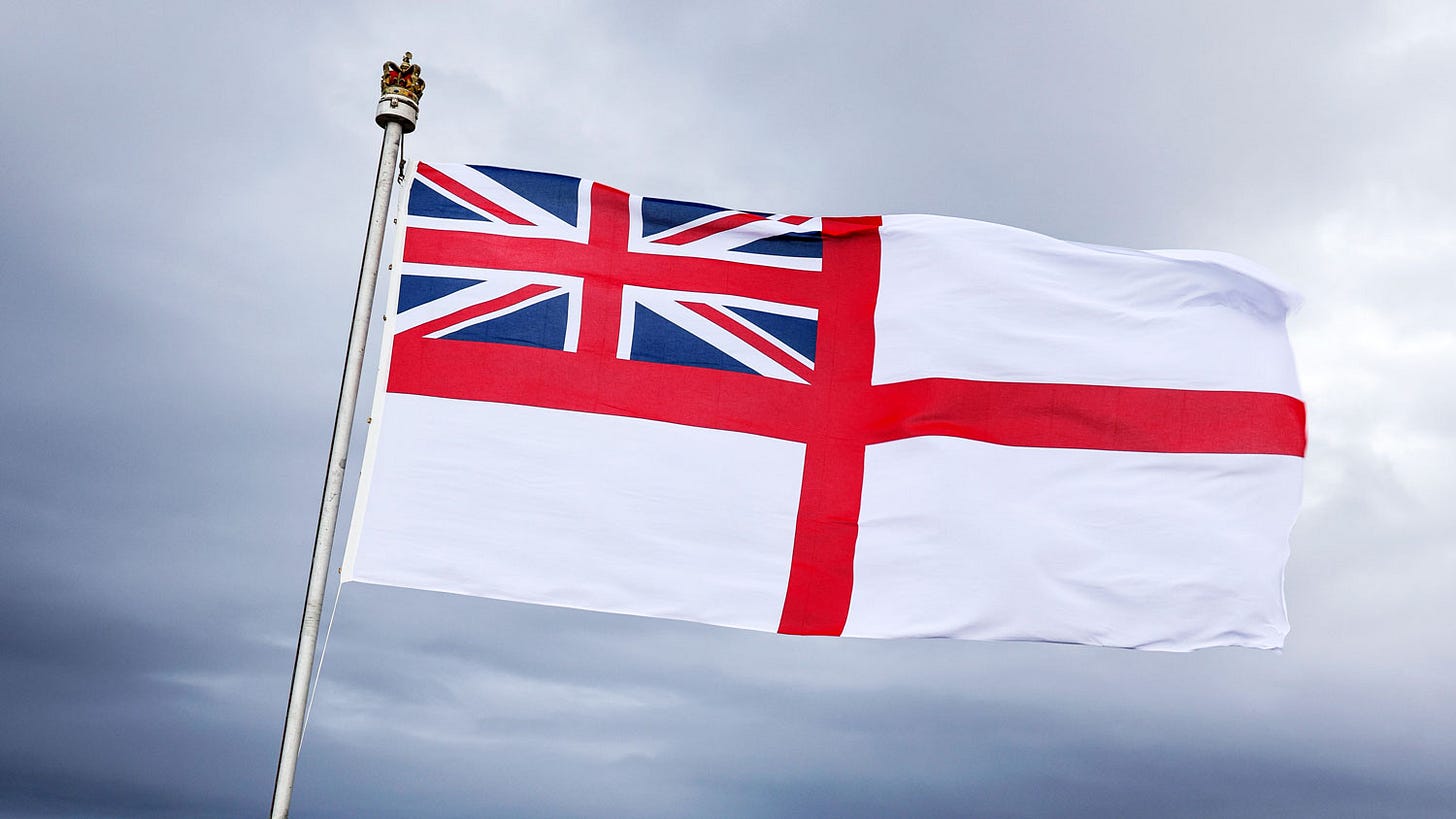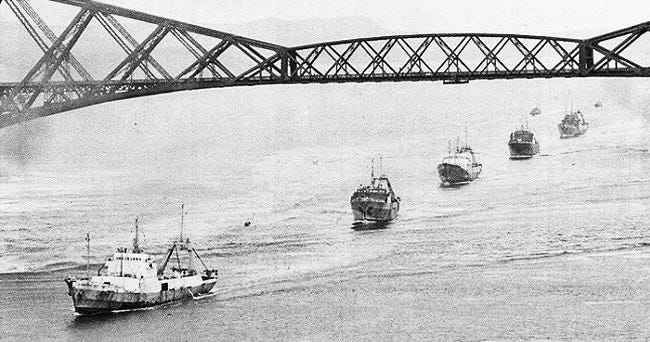3-JUL-1940: Operation Catapult - on 22-JUN, against previous agreement, France capitulated signing an Armistice with Germany, and the Vichy government came into being. Churchill and the Admiralty had pondered the fate of the French navy for some weeks. It was considered vitally imperative that neither the Germans nor the Italians should seize and operate any portion of the second largest navy - 7 battleships, 1 carrier, 19 cruisers, 78 destroyers and 81 submarines - in Europe after the RN, which included the modern battle-cruisers Dunkerque and Strasbourg, which were believed to be superior to the Scharnhorst and Gneisenau. French naval chief Admiral Darlan repeatedly refused to send his fleet to join de Gaulle’s Free French in Britain, or else order it to the West Indies or French Guyana. Thus, Churchill gave orders to conceive plans to neutralise the threat. All French vessels in British ports - 18 large and 200 lesser - would be boarded and seized; on the same day at Alexandria, Admiral Cunningham would persuade his friend Admiral Godfroy to disable his 11 ships that lay there. RN’s Mediterranean Force H under Admiral James Somerville (in HMS Hood) was sent to Mer-el-Kebir, Algeria to do the same with Admiral Gensoul. The situation played out very differently, and ultimately resulted in the deaths of some 1,300 French sailors. The principal reason for this was the haughty and intransigent nature of Gensoul, whose sense of honour was offended by Sommerville’s refusal to accept his word that no French ships would fall into Axis hands. He also misjudged Britain’s ruthless determination to resist Germany. After a frustrating day of negotiation, at 1730hrs Sommerville obeyed his orders and opened fire. Not all of the French ships were destroyed, but the action demonstrated Britain’s resolve to the world, in particular to Germany and USA. The action also soured relations between Britain and France for many years, but unequivocally, the French fleet should have been sent to Britain to significantly bolster the Atlantic fleet, or else relocate to one of France’s far-flung territories. One can conclude that these things did not come to pass, because Pétain’s Vichy France feared German reprisals.
Operation Catapult - French Warships Attacked at Mer-el-Kebir
10-JUL-1690: Nine Years War - Battle of Beachy Head - a combined English and Dutch fleet was beaten by the French under Comte de Tourville. The commander of the allies was the First Lord of the Admiralty, the Earl of Torrington. He had advised against engaging the superior French force, but with King William absent in Ireland, Queen Mary and her advisors - the ‘Council of Nine’ - overruled him. Torrington and the Dutch commander Admiral Evertsen may have disagreed over tactics, or perhaps had language/communication issues, because when the allied fleet met the French, the Dutch, in the van, closed aggressively whilst the English remained at maximum gun range. Consequently, the Dutch were badly mauled. In very light winds, with the tide running, Torrington ordered English ships to drop anchor, the French failed to realise this and drifted away, failing to capitalise. Victory notwithstanding, French superiority in the Channel would only be temporary. However, the manner of the defeat created a rift between the allies, and being Dutch, King William became embarrassed and angry and sought a scapegoat. For his initial reluctance to fight, and subsequent failure to reinforce the Dutch, Torrington’s rivals suggested he might be a traitor. He was imprisoned and later court-martialled, but acquitted; nevertheless, the monarchs dismissed him from his post. History has since vindicated Torrington’s judgement.
12-JUL-1776: Captain James Cook departs Plymouth on his third voyage in HMS Resolution. Admiralty orders were quite specific, this voyage was to be less concerned with the discovery and charting of new lands or with astronomy, botany and zoology; Cook’s principal task was to ascertain the existence of a passage between the Pacific and the Atlantic and/or North Sea. Besides which, there was no space for scientific equipment and sample jars, as the vessels’ holds were full of farm animals that King George III had ordered Cook to give to the people of Tahiti. Cook sailed to Cape Town, to await HMS Discovery commanded by Charles Clerke. Leaving there in November, they spent the whole of 1777 traversing the southern Indian Ocean to Australia, Tasmania and NZ, and on to Tonga and Tahiti. In mid-January 1778, Cook became the first European to discover the Hawaiian islands (Kauai), which he named the Sandwich Islands, after the First Lord of the Admiralty. Spring and summer 1778 saw them off the western shores of US and Canada, and thence to Alaska and the Aleutian Islands. Then the search for the NW Passage commenced. Cook managed to get to 70° 44’ N - further into the Arctic Circle than any other previous explorer. In mid-August he returned south to the Aleutians and Kamchatka, and decided to winter in the Sandwich Islands, and arrived at Maui in late-November, and then settled at Hawaii, where the mission was treated very well. They left Hawaii on very good terms, but were driven back by a storm. On their return, the reception was hostile. Relations soured badly with fatal consequences for Cook, four Marines and many islanders. Clerke took command and the mission went back to Kamchatka and into the Arctic Circle again, but still the passage could not be found. Later, Clerke died of TB in Kamchatka and John Gore took command, with James King skippering Discovery and completing Cook’s journals. They returned home - via Japan, Canton, Macau and Cape Town - in October 1780.
13-JUL-1982: Hull-based ocean-going fishing trawlers Cordella, Farnella, Junella, Northella and Pict leave Port Stanley in the Falkland Islands, so ending a remarkable tale. With the RN’s existing minesweepers too small to navigate the South Atlantic in safety, the North Sea trawlers - and crews - were requisitioned and commissioned as HMSs in the 11th Mine Counter-Measures Squadron.
The 11th Mine Counter-Measure Squadron Arrives in the Firth of Forth to Decommission - Mid-August 1982
14-JUL-1876: The boiler of the British battleship HMS Thunderer exploded during her full-power sea trial near Portsmouth, England - 45 sailors were killed and 40 injured.
15-JUL-1815: Keen to avoid capture by the Prussians and Austrians following the Battle of Waterloo Napoleon fled. He aimed to escape to America, but pre-warned as to his intentions, the RN blockaded the French Atlantic coast. Sheltering on Isle d’Aix off Rochefort, Napoleon decided to negotiate with the English and, “…throw myself on the protection of your Prince and laws…”. At daybreak, he was rowed out to HMS Bellerophon, where he surrendered to Captain Frederick Maitland, a Scotsman.
Admiral Henry Hotham in HMS Superb arrived on scene from Quiberon Bay just a few hours too late to claim the honour. After two days, HMSs Bellerophon and Myrmidon sailed for England where Napoleon’s fate would be decided.
18-JUL-1545: Battle of the Solent - the sinking of the Mary Rose. Launched in 1511, the vessel was rebuilt in 1536 to carry more, and bigger, guns. The design was defective and a seriously unbalanced ship materialised. Her gun ports were left open in the summer heat, and so when she heeled, there was a huge water ingress which quickly overwhelmed her. Over 400 men died.
18-JUL-1801: HMS Investigator under the command of Commander Mathew Flinders departed Spithead on a voyage to determine if New Holland (Australia) was one island.
19-JUL-1588: The Spanish Armada was first sighted off The Lizard. A chain of fire beacons along the south coast conveyed the news to London. The English fleet at Plymouth was temporarily held captive by the tide.
22-JUL-1797: War of the First Coalition - Battle of Santa Cruz de Tenerife - earlier in the year Admiral Jervis had achieved a great victory over the Spanish at Cape St Vincent, preventing them from joining the Franco invasion fleet. Keen to capitalise, the Admiralty ordered him to blockade the enemy in Cadiz. This was done poorly - not aided by the spirit of mutiny abroad in the RN that year. To make amends, Jervis sought to strike against the Spanish treasure fleet at Tenerife. Promoted, and knighted, after his exploits at Cape St Vincent, Nelson was given the lead task. He resolved to land troops at night and bombard the city from the sea, but neither aspect of his plan succeeded. After two days, Nelson re-jigged his plans and went on to lead the next assault himself. The Spanish were well prepared and the operation failed utterly. Nelson was wounded badly and his right arm was amputated. The British had to negotiate a withdrawal.
25-JUL-1815: HMS Bellerophon arrived at Brixham with Napoleon. Nobody was allowed either on or off the ship, yet news of Napoleon’s presence spread through to town and dozens of small boats ferried out many hundreds of curious locals who were keen to gain a glimpse of him as he took his daily walks upon the deck. Two days later Bellerophon was ordered to Plymouth and Napoleon was taken aboard HMS Northumberland for his one-way journey to St Helena.
HMS Bellerophon at Brixham - Local Jolly Boats Vie for a Glimpse of Napoleon
26-JUL-1690: Nine Years War - after Beachy Head, the French fleet anchored in Torbay, and about 1,000 men went ashore at Teignmouth intent on plunder. As well as destroying many small trading and fishing craft, they also robbed and burned over hundred premises and two churches. Many southern ports and towns suffered such destructive visits for at least 350yrs the Hundred Years War in 1340.
31-JUL-1970: Black Tot Day - after 230yrs of formal issue and probably over 350yrs of custom, the daily issue of ‘grog’ comes to an end. The last ship to enjoy the rum ration would be HMS Fife, as she was out in Pearl Harbour, Hawaii, the most westerly time-zone. A separate piece on this will follow.







